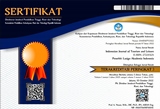Jelajah Sakai: Pengembangan Potensi Ethno-ecotourims Suku Sakai Riau
Abstract
This study discussed the potential for indigenous tourism of Sakai, Riau based on culture and nature. The Sakai tribe in Siak and Bengkalis regencies, Riau, is an indigenous tribe that has a unique culture and nature that is still origin. This paper aims to encourage multi-stakeholders to make the Sakai tribe a tourist destination. This research is a qualitative research, data obtained through observation, and in-depth interviews. The data were analyzed by discussing the theories of indigenous tourism from Hinch & Butler and Smith & Eadington, then written descriptively. This study found that the tourism potential of the Sakai very interesting, namely cultural tourism which includes their daily life starting from marriage, childbirth, economic activities, arts, culture, medical processions, historical tourism and nature tourism. Tourism management requires a collaborative networking effort, thus the Sakai tribe as the main actor in these tourism activities. This paper contributes to the study of indigenous and indigenous tourism, and becomes an important input for the government to develop indigenous tourism.
Keywords
Full Text:
PDFReferences
Airike, and Peppi-Emilia. 2012. “Collaborating for Corporate Social Responbility, the Case of Conflict Minerals in Global Supply Chains.” Master Thesis, Swedish University of Agricultural Sciences.
Berkes, Fikret. 2009. “Evolution of Co-Management: Role of Knowledge Generation, Bridging Organizations and Social Learning.” Journal of Environmental Management 90(5):1692–1702. doi: 10.1016/j.jenvman.2008.12.001.
Borrini-Feyerabend, G., M. T. Farvar, J. C. Nguinguiri, and V. A. Ndangang. 2007. Co-Management of Natural Resources: Organising, Negotiating and Learning-by-Doing. GTZ and IUCN. Heidelberg (Germany): Kasparek Verlag.
Coria, Jessica, and Enrique Calfucura. 2012. “Ecotourism and the Development of Indigenous Communities: The Good, the Bad, and the Ugly.” Ecological Economics 73:47–55. doi: 10.1016/j.ecolecon.2011.10.024.
Ghoddousi, Siavash, Pedro Pintassilgo, Júlio Mendes, Arash Ghoddousi, and Bernardete Sequeira. 2018. “Tourism and Nature Conservation: A Case Study in Golestan National Park, Iran.” Tourism Management Perspectives 26:20–27. doi: 10.1016/j.tmp.2017.12.006.
Harahap, and Amady. 2022. “Praktik Pengobatan Sakai Di Dusun Batin Sobanga Riau.” Jurnal Jurnal Etnoreflika 11(1):1–16.
Hinch, T. D., and R. W. Butler. 1996. Indigenous Tourism: A Common Ground for Discussion. In R.W. Buttler and T.D. Hinch (Eds), Tourism and Indigenous Peoples. London: International Thomson Business Press.
Justiccio, M. D. L., and Amady M.R.E. 2021. “Sedao Capitalism: Growth of Sakai Entrepreneurs in Duri Riau.” . . Budapest International Research and Critics Institute-Journal (BIRCI-Journal) 4(4):10479–90.
Melalatoa, M. J. 1995. Ensiklopedi Suku Bangsa Di Indonesia L-Z. Jakarta: Direktorat Sejarah dan Nilai Tradisional Direktorat Jenderal Kebudayaan.
Parker, Barry. 1993. “Developing Aboriginal Tourism — Opportunities and Threats.” Tourism Management 14(5):400–404. doi: 10.1016/0261-5177(93)90010-I.
Porath. N. 2003. “ Ketika Burung Itu Terbang, Terapi Shamanis Dan Pemeliharaan Batas-Batas Dunia Di Kalangan Orang-Orang Sakai Riau.” LAM Riau.
Purba, B. 2011. “Pengakuan Dan Perlindungan Hak-Hak Konstitusional Masyarakat Hukum Adat Sakai.” Disertasi, Universitas Islam Indonesia, Yogyakarta.
Ramchandra, J. 1910. Ancient India As Described By Ptolemy Being Written Geography. India: : Digital Library of India Item 2015.65897.
Salman, D. 2012. Manajemen Perencanaan Berbasis Komunitas Dan Mekanisme Kolaborasi Serta Peran Fasilitator. . Makassar: Sulawesi Capacity Development Project Kerjasama Kemendagri & JICA).
Shergold, Peter. 2008. “Governing through Collaboration.” in Collaborative Governance. ANU Press.
Skeat, W. W., and C. O. Blagden. 1906. Pagan Races of The Malay Peninsula. Vol. 1. New York: Macmillan and Co Limited.
Smith, V. L., and W. R. Eadington. 1992. Tourism Alternatives: Potentials and Problems in the Development of Tourism. Philadelphia: University of Pennsylvania Press.
Sugiwa, I. 2015. “Pengembangan Pariwisata Berbasis Keunikan Penduduk Lokal Di Wilayah Banten (Studi Di Wilayah Baduy).” Jurnal Epigram 12(2):133–44.
Sunaryo, S., and Bambang. 2013. Kebijakan Pembangunan Destinasi Pariwisata Konsep Dan Aplikasinya Di Indonesia. Yogyakarta: Gava Media Indonesia.
Suparlan, P. 1995. Orang Sakai Di Riau: Masyarakat Terasing Dalam Masyarakat Indonesia. Jakarta: Yayasan Obor Indonesia.
Thamrin. 2003. Sakai: Kekuasaan, Pembangunan, Dan Marjinalisasi. Pekanbaru: Gagasan Press Redaksi Tabloid Gagasan IAIN Susqa.
Wazan, Syafik, Retno Sunu Astuti, Kismartini Kismartini, and Teuku Afrizal. 2020. “Pengelolaan Kawasan Wisata Suku Anak Dalam Berbasis Kearifan Lokal.” PERSPEKTIF 9(2):418–27. doi: 10.31289/perspektif.v9i2.3884.
Zeppel, H. 2006. Indigenous Tourism Sustainable Development and Management. Cambridge: CABI.
DOI: https://doi.org/10.36256/ijtl.v3i1.210
Refbacks
- There are currently no refbacks.
Copyright (c) 2022 Indonesian Journal of Tourism and Leisure

This work is licensed under a Creative Commons Attribution-NonCommercial-ShareAlike 4.0 International License.
Indonesian Journal of Tourism and Leisure Indexed and Archieved By:

Indonesian Journal of Tourism and Leisure is licensed under a Creative Commons Attribution-NonCommercial-ShareAlike 4.0 International License.












